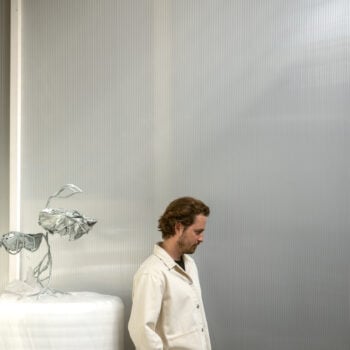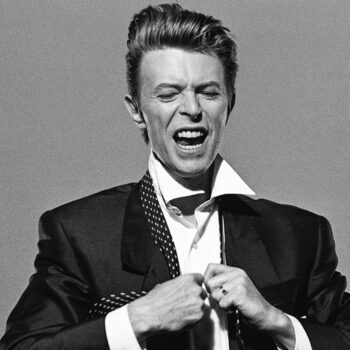Όταν ο street artist Cacao Rocks –κατά κόσµον Ιάσονας Μέγκουλας– έγραψε το 2010 σε έναν τοίχο «Athens is the new Berlin» (Η Αθήνα είναι το νέο Βερολίνο), µάλλον εξέφραζε κάποιον ευσεβή πόθο, παρά µια πραγµατικότητα. Η παρατεταµένη οικονοµική κρίση στην Ελλάδα δεν έδωσε πολλές ευκαιρίες στον ίδιο όταν τελείωσε το πανεπιστήµιο. Αντί να γίνει καθηγητής Γαλλικών, λοιπόν, στράφηκε στην τέχνη του δρόµου, αρχικά κάνοντας tagging στα όλο και περισσότερα ρηµαγµένα καταστήµατα και συνεχίζοντας µε murals και statements σχετικά µε το µεγάλο ποσοστό ανεργίας στη χώρα. Ο καλλιτεχνικός κόσµος της Αθήνας ήταν τότε σχεδόν «παγωµένος». Επτά χρόνια αργότερα, η καλλιτεχνική σκηνή της πρωτεύουσας άρχισε να ανθίζει. Το 2017 η Αθήνα κηρύχθηκε ανεπίσηµα ως η πιο καινούργια καλλιτεχνική πρωτεύουσα της Ευρώπης από την Documenta 14 –την πρώτη που διοργανώθηκε εκτός του Κάσελ της Γερµανίας– µε τίτλο Μαθαίνοντας απ’ την Αθήνα. Χρειάστηκαν µόνο 54 βαµµένα µπλε πρόβατα για να κάνει η έκθεση γνωστή την καλλιτεχνική σκηνή της πόλης σε ολόκληρο τον κόσµο!
Ωστόσο, η ανάδειξη της Αθήνας ως παγκόσµιας καλλιτεχνικής πρωτεύουσας είχε ξεκινήσει πολύ νωρίτερα. Ο µη κερδοσκοπικός Οργανισµός Πολιτισµού και Ανάπτυξης ΝΕΟΝ, µε ιδρυτή τον ∆ηµήτρη ∆ασκαλόπουλο, άρχισε να καθιερώνει την πόλη ως επίκεντρο της σύγχρονης τέχνης ήδη από το 2013, συνδυάζοντας την αρχιτεκτονική αποκατάστασή της µε την πολιτισµική ανάπτυξη. Από τις εκθέσεις που έχουν ξεχωρίσει έκτοτε είναι η Breaking News (2017), σε συνεργασία µε τον Βρετανό καλλιτέχνη Michael Landy, και οι 29 γλυπτές ανθρώπινες µορφές από σίδηρο του Sir Antony Gormley στη ∆ήλο (2019). Και οι δύο κέντρισαν το ενδιαφέρον της διεθνούς καλλιτεχνικής σκηνής. Πλέον, δεν είναι λίγοι οι καλλιτέχνες που έχουν µετακοµίσει µόνιµα στην Αθήνα, συµπεριλαµβανοµένου του Landy, ο οποίος είναι πια κάτοικος Εξαρχείων.

Η ιδρύτρια και υπεύθυνη της γκαλερί Rodeo, Σύλβια Κούβαλη, µοιράζει τον χρόνο της ανάµεσα στην ελληνική και τη βρετανική πρωτεύουσα. Ενώ δεν εκπροσωπεί αποκλειστικά Έλληνες καλλιτέχνες, λέει ότι «Έχουµε µεγάλη ευθύνη για την τοπική κοινότητα εδώ, στην Αθήνα», βοηθώντας τους να κινηθούν στην παγκόσµια σκηνή. Με την υποστήριξή της, η Χάρις Επαµεινώνδα κέρδισε τον Αργυρό Λέοντα στην Biennale της Βενετίας, ενώ ο Duncan Campbell το βραβείο Turner του Ηνωµένου Βασιλείου. Σηµαντικό µέρος του τελευταίου χρόνου η Κούβαλη το έχει περάσει στην Αθήνα, γεγονός που της επέτρεψε να επιστρέψει στις ρίζες της. «Αυτό το διάστηµα επέτρεψε σε όλους µας να κάνουµε πράγµατα που δεν µπορούσαµε όταν ταξιδεύαµε συνέχεια», λέει. Όπως το να συναντάµε τους γείτονες στο café της γωνίας ή το να βλέπουµε φίλους σε εξωτερικούς χώρους και να ανταλλάσσουµε ιδέες.
Αυτό που καταφέρνει ο καλλιτεχνικός κόσµος της Αθήνας είναι να βρει την ισορροπία ανάµεσα στο παγκόσµιο και το τοπικό, την ώρα που οι υπόλοιποι κλείνονται στον εαυτό τους. Η καλλιτεχνική διευθύντρια της Art Athina, Σταµατία ∆ηµητρακοπούλου, η οποία επέστρεψε στην Ελλάδα από το Λος Άντζελες για να αναλάβει την έκθεση, πιστεύει πως υπάρχει η δυνατότητα να αγγίξει ένα µεγαλύτερο κοινό διαδικτυακά. «Οι καλλιτέχνες και οι γκαλερί µπορούν να πειραµατιστούν», τονίζει και µε αφορµή την πρώτη ψηφιακή διοργάνωση της Art Athina τον περασµένο Οκτώβριο εξηγεί πως τόσο οι καλλιτέχνες όσο και οι επιµελητές πρέπει να κάνουν ένα δηµιουργικό άλµα προκειµένου να οραµατιστούν ότι βρίσκονται στον χώρο της έκθεσης. «Οι νεότεροι σκέφτονται πρώτα τη διαδικτυακή παρουσία και µετά τη φυσική, ενώ είναι άρρηκτα συνδεδεµένες», τονίζει.

Η Αθήνα δεν είναι µια προβλέψιµη πόλη, αλλά γεµάτη αντιθέσεις. Σε αυτή συνυπάρχουν το σύγχρονο µε το αρχαίο, το ευρωπαϊκό µε το καθαρά ελληνικό στοιχείο. Το κλίµα παίζει σηµαντικό ρόλο στην ιστορική της πορεία. Συγκρίνοντας τον καιρό στο Λονδίνο την ίδια ηµέρα (2 βαθµοί και βροχή) και στην Αθήνα (26 βαθµοί και ηλιοφάνεια), η Χλόη Βαΐτσου, διεθνής διευθύντρια της Art Dubai, σηµειώνει ότι η εγγύτητά της τόσο µε την Ευρώπη όσο και µε πρωτεύουσες της Ανατολής, όπως η Βηρυτός και το Κάιρο, της δίνει µια άλλη δυναµική, καθώς και τη δυνατότητα να χτίζει καλύτερα δίκτυα συνεργασίας και ανταλλαγής µεταξύ των πολιτισµών.
Μετά από έναν χρόνο πανδηµίας, η Αθήνα δείχνει να αντέχει περισσότερο από άλλες πόλεις, έστω και διαδικτυακά. Η διευθύντρια του οργανισµού ΝΕΟΝ, Ελίνα Κουντούρη, αναγνωρίζει πως, ενώ οι ψηφιακές πλατφόρµες κερδίζουν έδαφος, η τέχνη είναι κάτι που πρέπει κάποιος να βιώσει διά ζώσης. Είναι σίγουρη πως οι καλλιτέχνες θα παραµείνουν ευρηµατικοί και «θα συνεχίσουν να αντέχουν και να οραµατίζονται ένα µέλλον στο οποίο ο πολιτισµός θα ξεπερνά τον ψηφιακό κόσµο και θα βρίσκεται εκεί όπου ανήκει: ανάµεσά µας». Η επερχόµενη έκθεση Πύλη κάνει ακριβώς αυτό. Θα φιλοξενηθεί σε ένα ανακαινισµένο καπνεργοστάσιο, µε 40 καλλιτέχνες από την Ελλάδα και το εξωτερικό, µεταξύ των οποίων οι Michael Rakowitz, Glenn Ligon, Danh V και Μαρία Λοϊζίδου.







